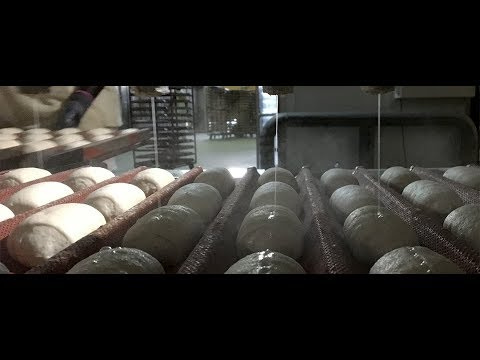This is the first piece in a series about artisanal bread.
I find staple foods beautiful, and none of them are as endlessly varied or complex as bread. The production of bread remains close to us, urban consumers, in a way the growing of rice or the farming of potatoes rarely is. We can pick a loaf of bread or a potato off the shelf with equal ease in the supermarket, but it took considerably more work to get the grain in the bread from the field to our shopping cart. The work of making that loaf is both strangely familiar and strangely invisible. Familiar because many people have at some point baked at home (and few of us have milled rice, or grown potatoes), and invisible because although much of the bread we buy is actually made relatively close to where we buy it, it’s made behind closed doors in anonymous buildings at odd hours.
This invisibility extends to popular culture, where bakers are not lionized the way chefs or even patissiers are. We take their work for granted because bread is so essential to civilization that it’s almost a synonym for food. The way we talk about food has changed over the years, so that we now acknowledge its centrality in our existence and its validity as a medium of expression. Meals are occasions, chefs are inventors, and dishes are art, and through all this, we haven’t really changed how we talk about bread. For someone to utter a saying about its importance marks them as quaint.
I wanted to write these pieces precisely because bread and baking seem to me to have been so overlooked in the discourse of our present foodie renaissance.
I also wanted to do this because every baker I know is still an optimist, and sometimes it’s nice to write about things from their point of view. The elite chefs I know are restless and competitive, partly because the media wants them to be. We don’t burden bakers, even the very best, with the same expectation. They bake because they like how it feels to shape a loaf with their hands, and because on some level they believe there should be work, bread, water, and salt for all. I think these instincts have largely been suppressed in elite kitchens, replaced with a search for what they call perfection.
Finally, the explosion in artisan baking over the last five decades prefigured the broader, more recent shift in American food culture. What it means to be an artisan bakery has also changed over that period, and professional bakers today grapple daily with questions that the restaurant industry will eventually have to answer. Questions like whether it’s meaningful for food to be made by people rather than machines, how to maintain that human element in the face of the brave new economy, and whether it’s really possible for us to produce the food we need in a way that is both satisfying and humane.
It felt natural to start by writing about the person who taught me how to bake. Jeffrey Hamelman and I have never met in person, and in fact we’d never spoken before I called him up to interview him for this article. But I learned to bake from his book, "Bread: A Baker's Book of Techniques and Recipes," which was so brilliant an instructional text, and so full of his personality, that working from it felt like being taught by the man himself. This was a privilege, since Hamelman is one of the most influential bakers in America, even if his name is mostly known to professionals. You can read a transcript of our conversation here.
I have a favor to ask - this newsletter is now 9 issues old, and I’d be delighted if it reached a wider audience. If you’ve enjoyed the stories so far, please consider sending a link or an issue along to someone you know who might find this interesting. There’s nothing like word of mouth. That’s it! And thank you!
Jeffrey told me about something I’d never heard of before: scoring bread with high pressure water jets.
Traditionally, it’s done with a razor blade, but this robot arm looks inefficient by comparison. There’s something pathetic about it, like Skynet trying to recapture the grace and variation of a human hand after replacing all the bakers with machines. Perhaps adding laser beams would help.
And an instagram hashtag devoted mostly to when human bakers have too much time on their hands. Spoiler: it involves razor blades, and bread dough.
Thank you for reading let them eat cake, a weekly newsletter about food systems and food. And as always, a super-special thank you to my pre-release readers, Jen Thompson and Diana Kudayarova.
best,
tw
p.s. I’d love to buy you a coffee. Drop me a line!


